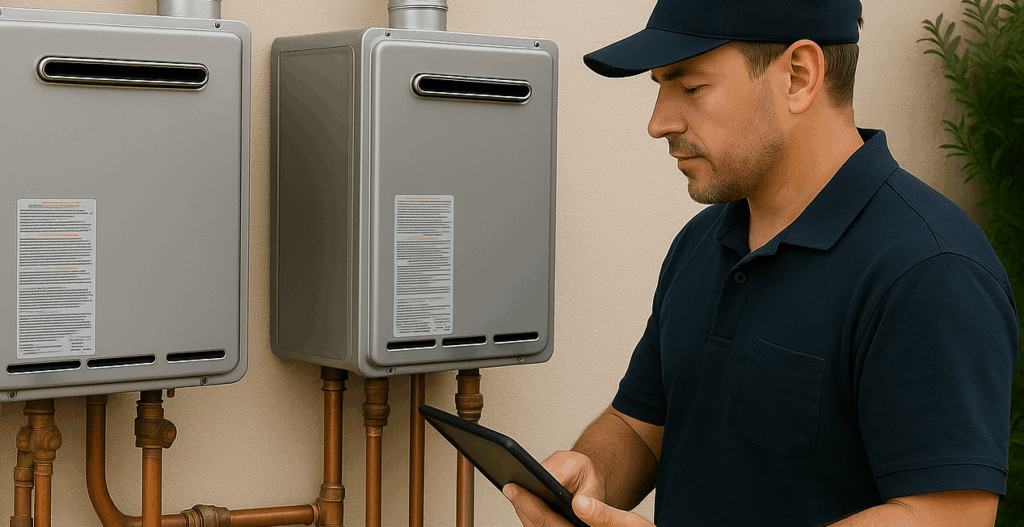A reliable water heater is essential for daily comfort, whether it’s for a hot shower on a chilly morning, sparkling clean dishes, or sanitized laundry. But like all appliances, your water heater needs regular maintenance to run efficiently, safely, and for as long as possible. Neglecting it can lead to breakdowns, expensive repairs, or even hazardous situations. If you want to get the most from your unit, here’s the ultimate guide to the do’s and don’ts of water heater maintenance.
Things You Need to Do:
Do Know Your Water Heater Type
Start by familiarizing yourself with your system. Is it a tank-style (storage) or tankless (on-demand) unit? Is it powered by gas, electricity, or even a heat pump? Read your owner’s manual and keep it handy – different models have unique maintenance needs, and knowing the specifics will save time and stress later on.
Do Check the Temperature Setting
Many water heaters are set at 140°F (60°C) by default. For most households, 120°F (49°C) is sufficient and safer. Lowering the temperature reduces scald risk, slows mineral buildup, and can save you up to 10% on your water heating bill.
Do Flush the Tank Regularly
If you own a traditional tank water heater, sediment can build up at the bottom, making the heater work harder and less efficiently. Once a year (twice if you have hard water), drain a few gallons from the tank or perform a full flush. This removes sediment, extends the unit’s life, and keeps energy use in check.
Do Inspect the Anode Rod
Inside your tank is an anode rod – a metal rod that attracts corrosive minerals to prevent rusting of the tank itself. Check the rod every 2-3 years. If it’s heavily corroded or less than half an inch thick, replace it. A healthy anode rod is your tank’s best line of defense against leaks.
Do Test the Pressure Relief Valve
The temperature and pressure relief (TPR) valve is a critical safety feature. At least once a year, test it by lifting the lever to let some water out (be careful – it’ll be hot!). If it doesn’t release water or doesn’t snap back, have it replaced. A functioning TPR valve prevents dangerous pressure buildup inside the tank.
Do Insulate Your Tank and Pipes
Insulating older water heaters and the first several feet of hot and cold water pipes reduces heat loss, helps water stay hot longer, and saves energy. For gas models, don’t cover the top, thermostat, or burner compartment. Pipe insulation also protects against freezing in colder climates.
Do Keep the Area Clean and Clear
Ensure there’s at least two feet of clearance around your water heater. This prevents fire hazards, improves airflow (for gas units), and makes it easier to spot leaks or perform maintenance. Regularly dust the area and gently clean the intake screens and burner compartment as needed.
Do Pay Attention to Warning Signs
Be alert for strange noises (rumbling, popping, hissing), rusty water, leaks, or fluctuating water temperature. These signs can indicate sediment buildup, a failing anode rod, or more serious issues. Addressing them early can save you from bigger repairs down the line.
Do Schedule Annual Professional Maintenance
Even if you handle basic upkeep, have a professional plumber inspect your system every year or two. They’ll flush the tank thoroughly, check the anode rod, inspect valves, check the thermostat and wiring, and look for early signs of trouble. Preventative maintenance is usually much less expensive than emergency repairs.
What NOT to Do:
Don’t Set the Temperature Too High
High temperature settings (above 140°F) increase the risk of scalding, promote faster mineral buildup, and waste energy. They can also strain the heater’s components, leading to premature failure. Stick to 120°F unless your manufacturer specifies otherwise.
Don’t Ignore Leaks or Moisture
Never ignore water pooling around your heater, dampness, or rust on the tank or pipes. Small leaks can quickly turn into big, expensive problems and may indicate tank corrosion or failing valves. Address leaks immediately – don’t wait for them to get worse.
Don’t Block the Airflow
For gas and some electric water heaters, good airflow is crucial. Don’t stack items or boxes around the unit, block the vent pipes, or cover intake screens. Blocked airflow can cause the heater to overheat or, in worst cases, lead to dangerous carbon monoxide buildup.
Don’t Attempt Major Repairs Yourself
While flushing the tank or adjusting the thermostat is safe for most homeowners, repairs involving gas lines, electrical wiring, or replacement of major components should be left to professionals. Incorrect repairs can void your warranty or create safety hazards.
Don’t Forget the Shutoff Procedures
Know where your water heater’s gas, water, and power shutoff valves are located. In an emergency, shutting these off quickly can prevent water damage or fire. Don’t attempt to drain or repair a leaking heater without first shutting off power (for electric) or gas and water (for gas models).
Don’t Overlook Local Codes and Manufacturer Guidelines
Building codes and manufacturer instructions are there for a reason. Don’t install, repair, or upgrade parts of your water heater without checking these guidelines. Improper installations can lead to inefficiency, code violations, or even hazardous conditions.
Don’t Let the Anode Rod Deteriorate
Neglecting the anode rod leads to premature tank failure due to internal corrosion. Schedule reminders to check and replace the rod as needed, especially in areas with hard water.
Don’t Ignore Age and Wear
Most tank water heaters last 8-12 years; tankless units can last 15-20 with proper maintenance. Don’t keep an aging unit past its expected lifespan – failure is more likely and could cause costly flooding. Plan for a replacement before the old one fails.
\Maximize Comfort, Safety, and Savings
Proper water heater maintenance isn’t complicated, but it does require some attention and care. Follow these do’s and don’ts to maximize your heater’s efficiency, extend its lifespan, and ensure the safety of your home. Regular checks, temperature management, cleaning, and professional inspections go a long way toward keeping hot water available when you need it without the worry of breakdowns or costly repairs. Take a little time each year to care for your water heater, and it will provide you with comfort and peace of mind for years to come.

